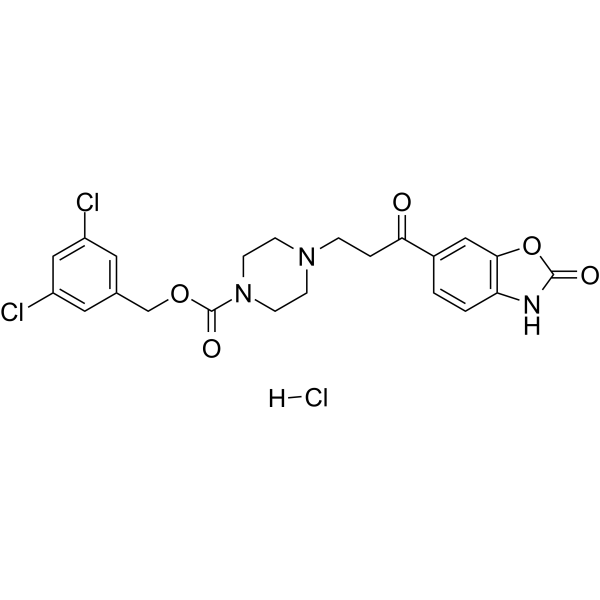产品
编 号:F748640
分子式:C22H22Cl3N3O5
分子量:514.79
分子式:C22H22Cl3N3O5
分子量:514.79
产品类型
规格
价格
是否有货
5mg
询价
询价
10mg
询价
询价
25mg
询价
询价
50mg
询价
询价
100mg
询价
询价
结构图

CAS No: 2070015-01-7
产品详情
生物活性:
PF-8380 hydrochloride is a potent autotaxin inhibitor with an IC50 of 2.8 nM in isolated enzyme assay and 101 nM in human whole blood.
体内研究:
The pharmacokinetic profile of PF-8380 is evaluated at an intravenous dose of 1 mg/kg and oral doses of 1 to 100 mg/kg out to 24 h. PF-8380 has mean clearance of 31 mL/min/kg, volume of distribution at steady state of 3.2 L/kg, and effective t1/2 of 1.2 h. Oral bioavailability is moderate, ranging from 43 to 83%. Plasma concentrations increased with single oral escalating doses, but Cmax increased at a rate that is approximately proportional to dose from 1 to 10 mg/kg and less than proportional to dose from 10 to 100 mg/kg. PF-8380 exposures estimated by area under the curve are approximately proportional to dose and linear up to 100 mg/kg. Plasma C16:0, C18:0, and C20:0 LPA levels are measured immediately after collection. Maximal reduction of LPA levels is observed by the 3 mg/kg dose at 0.5 h with all LPA returning at or above baseline at 24 h. Treatment with 10 mg/kg PF-8380 increases tumor-associated vascularity modestly by 20% (P=0.497). When compared to control, treatment of PF-8380 45 min before 4 Gy irradiation decreases vascularity by nearly 48% when compared to control (P=0.031) and by 65% when compared to mice that received radiation alone (P=0.011).
体外研究:
PF-8380 also inhibits rat autotaxin with an IC50 of 1.16 nM with FS-3 substrate. Potency of PF-8380 is maintained when using enzyme produced from fetal fibroblasts used in combination with lysophosphatidyl choline (LPC) as a substrate. In human whole blood incubated with PF-8380 for 2 h, autotaxin is inhibited with an IC50 of 101 nM. Autotaxin (ATX), an enzyme with lysophospholipase D (lysoPLD) activity, catalyzes the production of lysophosphatidic acid (LPA) from lysophosphatidylcholine (LPC). Pre-treatment of GL261 and U87-MG cells with 1 μM PF-8380 followed by 4 Gy irradiation results in decreased clonogenic survival, decreases migration (33% in GL261; P=0.002 and 17.9% in U87-MG; P=0.012), decreases invasion (35.6% in GL261; P=0.0037 and 31.8% in U87-MG; P=0.002), and attenuates radiation-induced Akt phosphorylation.
PF-8380 hydrochloride is a potent autotaxin inhibitor with an IC50 of 2.8 nM in isolated enzyme assay and 101 nM in human whole blood.
体内研究:
The pharmacokinetic profile of PF-8380 is evaluated at an intravenous dose of 1 mg/kg and oral doses of 1 to 100 mg/kg out to 24 h. PF-8380 has mean clearance of 31 mL/min/kg, volume of distribution at steady state of 3.2 L/kg, and effective t1/2 of 1.2 h. Oral bioavailability is moderate, ranging from 43 to 83%. Plasma concentrations increased with single oral escalating doses, but Cmax increased at a rate that is approximately proportional to dose from 1 to 10 mg/kg and less than proportional to dose from 10 to 100 mg/kg. PF-8380 exposures estimated by area under the curve are approximately proportional to dose and linear up to 100 mg/kg. Plasma C16:0, C18:0, and C20:0 LPA levels are measured immediately after collection. Maximal reduction of LPA levels is observed by the 3 mg/kg dose at 0.5 h with all LPA returning at or above baseline at 24 h. Treatment with 10 mg/kg PF-8380 increases tumor-associated vascularity modestly by 20% (P=0.497). When compared to control, treatment of PF-8380 45 min before 4 Gy irradiation decreases vascularity by nearly 48% when compared to control (P=0.031) and by 65% when compared to mice that received radiation alone (P=0.011).
体外研究:
PF-8380 also inhibits rat autotaxin with an IC50 of 1.16 nM with FS-3 substrate. Potency of PF-8380 is maintained when using enzyme produced from fetal fibroblasts used in combination with lysophosphatidyl choline (LPC) as a substrate. In human whole blood incubated with PF-8380 for 2 h, autotaxin is inhibited with an IC50 of 101 nM. Autotaxin (ATX), an enzyme with lysophospholipase D (lysoPLD) activity, catalyzes the production of lysophosphatidic acid (LPA) from lysophosphatidylcholine (LPC). Pre-treatment of GL261 and U87-MG cells with 1 μM PF-8380 followed by 4 Gy irradiation results in decreased clonogenic survival, decreases migration (33% in GL261; P=0.002 and 17.9% in U87-MG; P=0.012), decreases invasion (35.6% in GL261; P=0.0037 and 31.8% in U87-MG; P=0.002), and attenuates radiation-induced Akt phosphorylation.
产品资料

